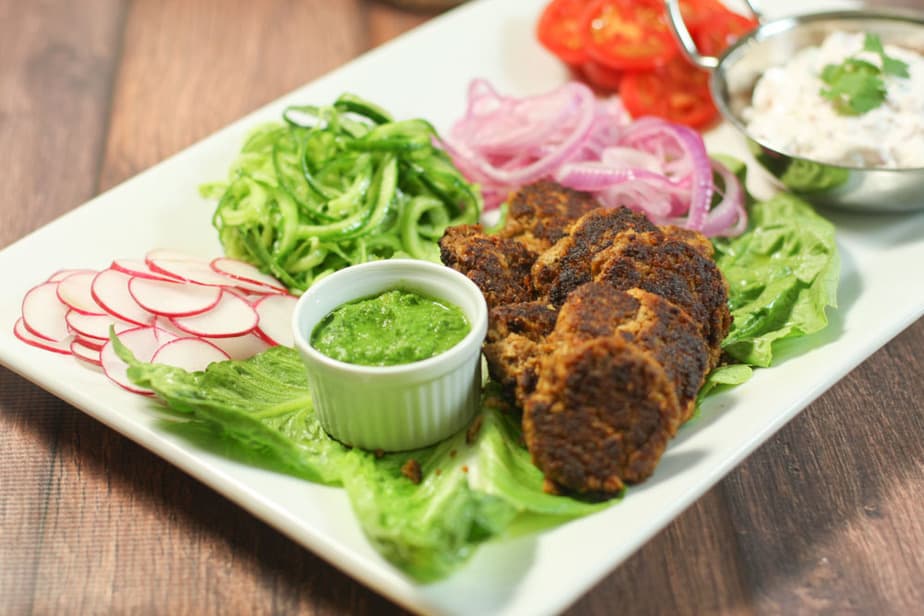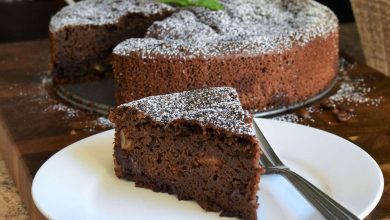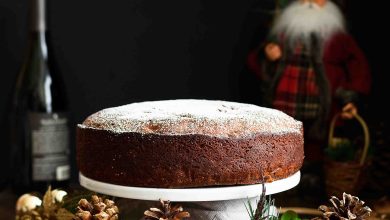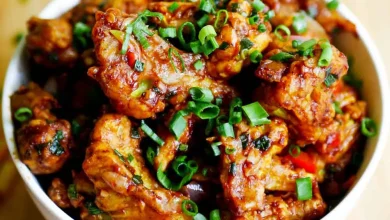Introduction
Embarking on a culinary journey into the realm of Nawabi cuisine, the Chicken Galauti Kebab stands out as a quintessential delicacy that epitomizes the art of slow cooking, aromatic spice blending, and tender meat preparation. Originating from the historic city of Lucknow, India, these kebabs are renowned for their melt-in-the-mouth texture, intense flavor profile, and sophisticated presentation. Crafted meticulously with boneless chicken, a proprietary mix of spices, and natural tenderizers like raw papaya, this dish exemplifies the finesse of traditional Mughlai and Awadhi culinary techniques.
The Love With Recipes platform is dedicated to providing comprehensive, authentic recipes that not only satisfy your palate but also enrich your culinary knowledge. This detailed recipe aims to guide you through every aspect of preparing Chicken Galauti Kebabs, ensuring that each bite transports you to the royal kitchens of the Mughal emperors. With a focus on precision, flavor harmony, and presentation, this recipe is suitable for both novice cooks and seasoned chefs eager to recreate a culinary masterpiece at home.
Time
Preparation and Cooking Duration
Cooking time for these kebabs totals approximately 30 minutes, with the preparation phase taking around 20 minutes, and the actual cooking process requiring about 10 minutes per batch. While the active cooking is brief, the marination time of at least 1 hour is essential for developing the characteristic tenderness and flavor infusion. For optimal results, consider preparing the mixture in advance and allowing it to rest in the refrigerator to deepen the flavors.
Needed Equipment
- Mixing bowls (large and medium-sized)
- Grinder or food processor (preferably with a wet grinding option)
- Measuring spoons and cups
- Non-stick frying pan or skillet
- Slotted spatula or tongs
- Kitchen towel or paper towels for draining excess oil
- Plastic wrap or airtight container for marination
- Sharp knife for shaping the kebabs
- Serving platter
- Optional: Skewers for grilling or charring
Tags
Indian cuisine, Mughlai, Awadhi, Kebabs, Chicken recipes, Party starters, Traditional recipes, Authentic cooking, Gourmet, Street food style, Special occasion, Festive dishes
Serving Size
This recipe yields approximately four generous servings, ideal for sharing as an appetizer or part of a multi-course meal. Each serving offers a succulent, flavorful kebab that balances richness with aromatic spices, complemented by traditional chutneys or dips.
Difficulty Level
Intermediate. While the process involves some precise steps such as blending and shaping the kebabs, the overall method is straightforward. Attention to detail—particularly during marination and frying—ensures professional-quality results. Beginners with basic cooking skills can successfully master this dish with patience and careful execution.
Allergen Information
- Contains: Chicken, gluten (gram flour), spices (may cause allergies in sensitive individuals)
- Note: The recipe does not include common allergens like dairy, nuts, or eggs, but always verify spice purity and ingredient sources if allergies are a concern.
Dietary Preference
Non-vegetarian. This recipe is suitable for a high-protein diet and can be adapted for gluten-free preferences by substituting gram flour with gluten-free alternatives such as rice flour or chickpea flour.
Course
Appetizer or starter.
Cuisine
Indian, Mughlai, Awadhi
Ingredients
| Ingredient | Quantity |
|---|---|
| Boneless chicken (minced) | 1/2 kg (500 grams) |
| Raw papaya paste | 2 tablespoons |
| Onion paste | 2 tablespoons |
| Ginger paste | 1/2 tablespoon |
| Garlic paste | 1/2 tablespoon |
| Cardamom powder (Elaichi) | 1/2 teaspoon |
| Red chili powder | 1 teaspoon |
| Gram flour (besan) | 1 tablespoon |
| Garam masala powder | 1/4 teaspoon |
| Mace powder | 1/4 teaspoon |
| Coriander powder (Dhania) | 1/2 teaspoon |
| Salt | As needed |
| Sunflower oil | As required for frying |
Instructions
Step 1: Preparing the Chicken Mixture
Begin by selecting fresh, high-quality boneless chicken. Rinse the minced chicken thoroughly under cold running water to eliminate any residual blood or impurities. Use your hands or a slotted spoon to drain excess water, ensuring the meat is just moist enough for marination. Pat dry with a paper towel if necessary, to prevent dilution of the marinade.
In a large mixing bowl, combine the minced chicken with the raw papaya paste. Raw papaya is a key ingredient that acts as a natural meat tenderizer due to the presence of enzymes like papain. This enzyme breaks down connective tissue, resulting in an incredibly tender kebab. Use a fresh, ripe papaya or a jarred paste, ensuring it is free from preservatives or added sugars.
Add the onion paste, ginger paste, and garlic paste to the bowl. These pastes are freshly made or store-bought, and they contribute both flavor and moisture to the mixture. The onion paste provides sweetness and helps in binding, while ginger and garlic add pungency and depth.
Next, incorporate the dry spices: cardamom powder, red chili powder, garam masala, mace powder, coriander powder, and salt. These spices are essential for creating the authentic aroma and flavor profile characteristic of Mughlai cuisine. Measure carefully to maintain balance; too much spice can overpower the subtlety, while too little may result in a bland taste.
Finally, add the gram flour (besan). This ingredient functions as a binding agent, ensuring the kebabs hold their shape during frying and contribute a slight nutty flavor that complements the spices.
Mix all ingredients thoroughly using a clean spoon or your hands, ensuring an even distribution of spices and paste. Cover the bowl with plastic wrap or a tight-fitting lid and refrigerate for at least 1 hour. This resting period allows the flavors to meld and the enzymes to tenderize the chicken, resulting in a more succulent kebab.
Step 2: Shaping the Kebabs
After marination, transfer the mixture to a food processor or grinder. Pulse briefly until you achieve a smooth, homogeneous paste. This step is crucial for a melt-in-the-mouth texture, as it breaks down the mixture further and ensures uniformity.
Divide the mixture into equal portions, approximately the size of a medium-sized lemon or small fist. Using your hands, shape each portion into a round or oval patty. Gently press each shape to create a slightly flattened surface—this aids in even cooking and presentation. For a traditional look, you can thread the kebabs onto small skewers or shape them freehand on a plate.
Step 3: Frying the Kebabs
Heat a non-stick frying pan or skillet over low to medium-low heat. Add enough sunflower oil to submerge at least half of the kebabs during frying. This method ensures even cooking and a crispy exterior.
Carefully place the kebabs into the hot oil, ensuring they do not touch or overlap. Fry in batches if necessary, to prevent overcrowding, which can lower the oil temperature and lead to soggy kebabs.
Cook the kebabs over low heat for approximately 15-20 minutes on each side. Use tongs or a slotted spatula to flip them gently. The low heat allows the kebabs to cook slowly, ensuring the interior remains tender and moist while the exterior develops a beautiful golden-brown crust.
Monitor the temperature closely. If the kebabs brown too quickly, lower the heat further. If they are taking too long to brown, increase the heat slightly, but avoid high flames that can burn the spices or cause uneven cooking.
Ensure the kebabs are thoroughly cooked by checking that the internal temperature reaches at least 75°C (165°F) or by cutting one open to verify no raw meat remains. The internal color should be opaque and juicy.
Step 4: Serving the Kebabs
Once cooked, transfer the kebabs onto a paper towel-lined plate to drain excess oil. For presentation, arrange the kebabs on a decorative platter. Garnish with freshly chopped coriander leaves or thinly sliced onions, which add freshness and texture.
Serve hot, accompanied by traditional condiments such as Dhaniya Pudina Chutney or cooling yogurt-based dips. These accompaniments enhance the flavor and provide a refreshing contrast to the rich, spiced kebabs.
Preparation Tips
- Marination Duration: While a minimum of 1 hour is recommended, marinating overnight enhances flavor penetration and tenderness. For best results, plan ahead and prepare the mixture a day in advance.
- Consistency: Achieve the perfect smoothness in the mixture by blending it thoroughly. If the mixture seems too dry, add a teaspoon of water or a splash of oil during blending.
- Spice Balance: Adjust the spice quantities based on your preference for heat and aroma. Remember, spices intensify during cooking, so start with conservative amounts.
- Cooking Temperature: Low and slow is the key to authentic Galauti Kebabs. High heat can cause burning and uneven cooking, compromising texture and flavor.
- Optional Smoking: For an authentic smoky flavor, you can char the kebabs briefly over an open flame or infuse with smoke using a traditional ‘dhungar’ method.
Nutritional Information
| Nutrient | Per Serving (Approx.) |
|---|---|
| Calories | 275 kcal |
| Protein | 23 g |
| Fat | 18 g |
| Carbohydrates | 7 g |
| Fiber | 1 g |
| Sodium | 480 mg |
Tips and Tricks
- Freshness Matters: Use fresh spices and herbs for vibrant aroma and flavor. Store spices in airtight containers away from light and heat.
- Meat Quality: Opt for high-quality, fresh boneless chicken. Organic or free-range chicken adds to the flavor profile and ensures better texture.
- Binding Alternatives: If gram flour is unavailable, substitute with chickpea flour or rice flour, but adjust quantities to maintain binding and texture.
- Shape Variations: For a more authentic presentation, shape the kebabs onto skewers or roll them into small balls before frying.
- Serving Temperature: Serve immediately after frying to enjoy the kebabs at their best, with a crispy exterior and tender interior.
- Flavor Enrichment: Incorporate a dash of saffron water or rose water during marination for added aroma.
Add-ons
- Finely chopped green chilies for heat
- Chopped mint leaves for freshness
- Crumbled dried fenugreek leaves (Kasuri methi) for earthy flavor
- Finely sliced ginger for extra zing
Side Dishes
- Freshly baked naan or roomali roti
- Green chutney (coriander-mint)
- Yogurt or raita with cucumber and cumin
- Pickled onions or lemon wedges
- Salad with fresh vegetables such as cucumber, tomato, and lettuce
Improvements and Variations
- Vegetarian Version: Substitute chicken with paneer or mashed potatoes mixed with spices for a vegetarian adaptation.
- Spice Customization: Increase or reduce spices like red chili or garam masala to suit your heat preference.
- Cooking Methods: Try grilling the kebabs over charcoal for a smoky flavor or baking in a preheated oven at 180°C (356°F) for a healthier option.
- Flavor Infusion: Infuse the oil with whole spices like cinnamon sticks or cloves before frying for an added aromatic dimension.
Save and Store
Leftover kebabs can be stored in an airtight container in the refrigerator for up to 2 days. Reheat gently in a pan over low heat or in the oven to maintain their texture. To freeze, arrange shaped kebabs on a tray, freeze until firm, then transfer to a zip-lock bag. They can be refrigerated for up to 1 month. Reheat thoroughly before serving.
FAQ
Can I prepare the mixture in advance?
Yes, marinate the mixture for at least 1 hour, but for enhanced flavor and tenderness, prepare it a day ahead and refrigerate overnight.
Can I bake these kebabs instead of frying?
Absolutely. Preheat your oven to 180°C (356°F). Place the shaped kebabs on a baking sheet lined with parchment paper. Brush lightly with oil and bake for 20-25 minutes, flipping halfway through, until golden and cooked through.
What if I don’t have raw papaya?
Yogurt can be used as a substitute, although it may slightly alter the tenderness. Use 2 tablespoons of full-fat yogurt mixed into the mixture.
How do I achieve authentic smoky flavor?
Use a small charcoal piece, heat until red-hot, place it in a small bowl within the kebabs, and pour a teaspoon of ghee or oil over it. Cover immediately to trap the smoke for 5-10 minutes.
Can I make these vegetarian?
Yes, substitute minced chicken with mashed paneer, tofu, or cooked chickpeas, combined with spices and binding agents.
Conclusion
Recreating the regal taste of Chicken Galauti Kebabs at home is a rewarding culinary experience that combines traditional techniques with modern convenience. The meticulous process of marination, blending, shaping, and slow frying results in a dish that is both flavorful and tender, making it perfect for special occasions or an indulgent weekend treat. With attention to detail and patience, you can elevate your home cooking to match the finesse of renowned Mughlai kitchens. Remember, the key lies in quality ingredients, precise spice balancing, and gentle cooking. Explore the endless possibilities for customization and pair these kebabs with vibrant chutneys and fresh bread to create a memorable meal. Happy cooking!
References
1. India Curry – Authentic Mughlai Recipes
2. Sanjeev Kapoor – Mughlai Cuisine Techniques





